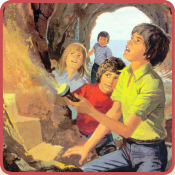
Oh! What a Lovely Time

Book Details...
First edition: 1949
Publisher: Brockhampton Press
Illustrator: Jeanne Farrar
Category: Brockhampton Nursery Series
Genre: Fantasy
Type: Short Story Series Books
Publisher: Brockhampton Press
Illustrator: Jeanne Farrar
Category: Brockhampton Nursery Series
Genre: Fantasy
Type: Short Story Series Books
On This Page...


Endpapers
The storyline involves Miss Roundy's little toy-shop which also sells sweets and chocolates. Naturally it's a real attraction for the local children who visit each day to press their noses to the window and wish. Didn't we all? The children love Miss Roundy who is very generous and nearly always gives them an extra sweet in their bags when they come to spend their pennies. The toys also love her because she looks after them very well. She mended a hole in the beautiful golden haired doll's dress and found a new key for the train when its original one got lost and she even repainted a rubbed-off spot on one of the soldiers' red-coats. Yes, there's happiness all round but the best thing in life for the toys is to see the children coming into the shop with their pocket-money and perhaps buying one or other of them.
Unfortunately, gloom descends onto the happy scene when it is found that when Christmas arrives, Miss Roundy is going to close the shop for four whole days. No one will visit over that period. No one will come in to buy something or to look at the toys and remark how lovely they all are. "Four days of dullness, quietness and darkness!" said the golliwog.
Here comes the plan: The toys will hold a big Christmas party for themselves to fill in the empty days and at the same time it will supply a great deal of liveliness and excitement for the Festive Season.
Miss Roundy departs and the toys commence preparations. The golly is the spokesman and very much in charge of things. The dolls will naturally do the cooking, and the white cat and the black monkey can help to arrange the toy circus which will supply added entertainment. The clockwork sailor will decorate the Christmas tree. The excitement garnered by all the activity naturally causes a few little squabbles here and there but these are part of most Enid Blyton stories that involve characters and they're always interesting. Despite this, the toys all pull together and work hard on their project.
The roly-poly man is a bit of a nuisance when he keeps bumping into people. First it's the soldiers who fall over like ninepins and then he rolls against the golden-haired doll who's taking some lovely cherry-topped cup-cakes from the oven. Two of them fall off and are quickly eaten by the cat but there are plenty left and Jeanne Farrar puts in a colourful picture of the spread when it's all ready. It reminds me very much of the meals that confronted us in the days when birthday parties were Birthday Parties — there's trifle, a tall jelly, chocolates, cup-cakes, toffees, and all kinds of delicious-looking goodies as well as a large iced cake with tiny candles planted in it. The picture doesn't show the candles but perhaps they were put on a little later.
The Jack-in-the box is let out although the toys are a little apprehensive of him because he has a tendency to scare people but they relent and he joins the throng although the golden-haired doll has to smack him on the nose when he licks some sugar off a bun! The circus is set up and Mr. Noah lends them two horses from his ark as well as a couple of lions and tigers and bears and even two elephants. Old Noah can do that because he's an animal man of renown.
You can well imagine the rest of the story — the wonderful circus show precedes a marvelous nosh-up. Presumably the tiniest doll who is dressed as a fairy and stuck on top of the tree is allowed down to join in (of course she would). Then the games commence. The trains and motor cars give everyone rides and this shows the distinct advantage of living in a toy shop. In an ordinary nursery there would be one train and probably one car, but here there are several of each in this case due to the nature of the establishment.
There's dancing of course although the roly-poly man keeps getting in the way and bumping people but it's nothing to write home about! The Christmas tree also has candles and, no doubt, they cast a warm glow on the scene of Christmas in its purity. There really couldn't be anything more desired but then, Lo and Behold ... there is something else to come! The clockwork sailor has gone to fetch a visitor — someone who epitomizes what Christmas is all about for children and for toys. On arrival, this guest is the cause of much excitement and happiness and the occasion is a fitting end to a wonderful Christmas for all the inhabitants of Miss Roundy's toyshop.
There's a tiny twist at the end of the tale and the question is — should it be revealed? I think it could be because this little book which came out in 1949 seems to be out of print and as it's small-time, the revelation wouldn't be anything like disclosing the result of a mystery in the Find-Outers or Arnold series. The fact is that the special visitor who arrives is none other than the clockwork sailor!
The book is roughly 13cm square and contains over fifty pages and thirty pennies is the price.
Inside the front and back covers is a dramatic picture done in red of the roly-poly man knocking down the soldiers. The artistry of Jeanne Farrar has plenty of the characteristics that typified many pictures produced in the 1940s and Fifties.
The clockwork sailor was, of course, disguised as You-Know-Who!
The whole book from a scarce book that has never been reprinted in this format.


























































































































